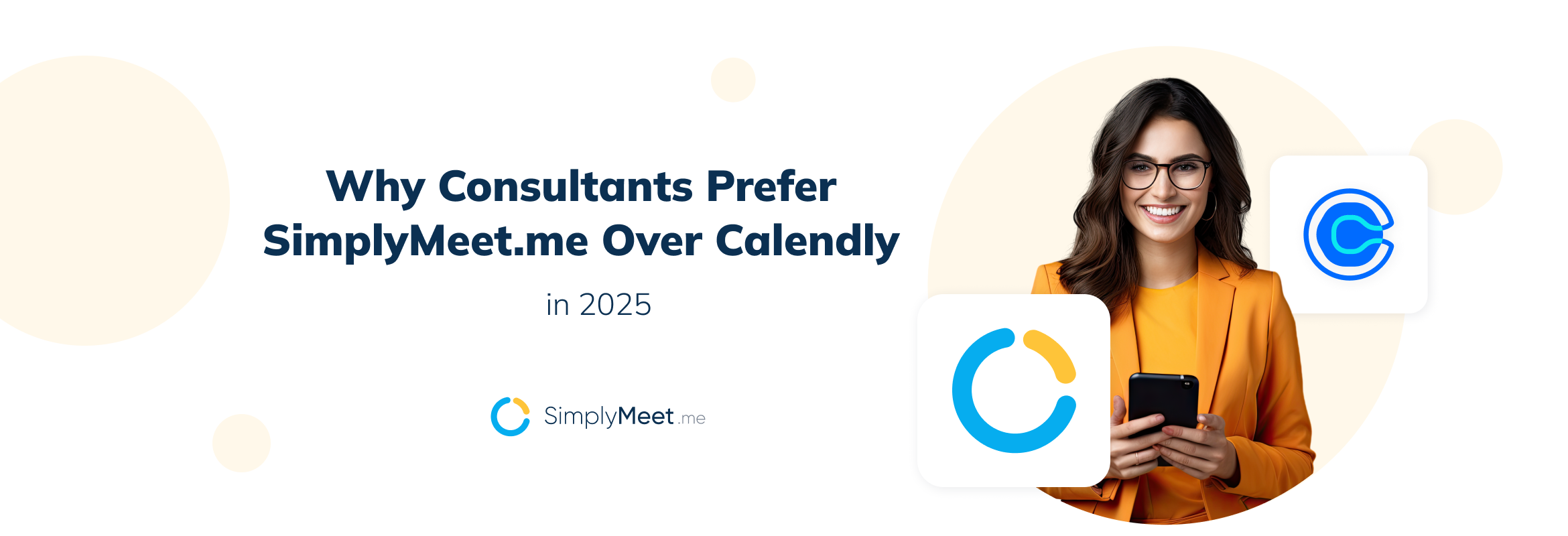How to Run a Successful Client Meeting: Tips and Best Practices

In a world brimming with pings, DMs, and Slack threads, the simple act of a scheduled client meeting still holds remarkable power. It’s not just about discussing project timelines or contract terms — it’s about building relationships, aligning goals, and demonstrating credibility in real-time.
But let’s be honest: not all meetings are created equal. Some drag on without direction, others feel like a monologue. The difference between a good meeting and a great one? Intention, structure, and the right tools to support the flow. A good meeting might check a box. A great meeting lays the foundation for a long-term partnership.
That’s where SimplyMeet.me comes in. Designed to take the chaos out of coordination, SimplyMeet.me streamlines the “meet the client” experience from the very first invite. Automated scheduling, seamless calendar syncing, and smart integrations mean you can spend less time organizing — and more time actually connecting with your clients.
In this guide, we’ll break down everything you need to know to run an effective client meeting, from the moment you send that invite to the final follow-up. Whether you’re a solo consultant or a full-scale agency, these tips and best practices will help you elevate every client interaction into something meaningful — and profitable.
I. Why Client Meetings Still Matter in 2025
You’d think by now, in the age of instant messaging and AI-generated reports, traditional client meetings would’ve lost their relevance. But the truth? They’re more essential than ever. Despite the digital noise, clients crave genuine connection — and the most impactful conversations still happen when you carve out dedicated time to meet the client, whether across a table or through a screen.
Communication tools have evolved, sure. We’ve swapped boardrooms for Zoom calls and conference rooms for shared Google Docs. But tools alone can’t replicate the nuance of human interaction: the ability to read tone, respond to questions in real time, or pivot based on subtle client cues. That’s the edge a live client meeting delivers — it builds trust faster than a dozen email threads ever could.
Meeting the client face-to-face (or face-to-screen) also shortens the distance between assumption and understanding. Misalignment kills momentum, and there’s no better way to ensure everyone’s on the same page than by talking it out, live and direct.
And the benefits? They’re impossible to ignore. Well-run client meetings lead to better retention, deeper engagement, and stronger referrals. When clients feel seen, heard, and understood, they don’t just stay — they advocate. In a marketplace where relationships drive revenue, the value of a powerful meeting is beyond measure.
SimplyMeet.me helps make this all happen without the scheduling chaos. Because the future of business communication isn’t fewer meetings — it’s better ones.
II. Preparation: What to Do Before You Meet the Client
Before you even think about jumping into a client meeting, preparation is your secret weapon. Because while spontaneity might work in casual chats, high-stakes meetings demand strategy. To meet the client confidently — and leave a lasting impression — the groundwork needs to be flawless.
Start with research. Know who you’re talking to. Study the client’s company background, recent initiatives, and industry trends. What pain points are they likely facing? What goals are they chasing? The more context you bring to the table, the more tailored and relevant your conversation will be. This isn’t just about being informed — it’s about showing the client you value their time enough to come prepared.
Know your attendees. Who’s joining from your side? A sales manager? A technical lead? Align internally before the meeting. Make sure everyone understands the meeting objectives, knows their role, and is speaking from the same playbook. Mixed messages create confusion — and in client meetings, clarity is currency.
Then, gather your tools. Whether it’s a presentation, a performance dashboard, or a product demo, don’t leave anything to chance. Have everything queued up and easily accessible — and always prepare for what-if scenarios (unstable Wi-Fi, last-minute attendee changes, or unexpected questions).
Next: scheduling. Ditch the email ping-pong. SimplyMeet.me makes coordinating meeting times seamless with smart booking pages, calendar integrations, and automated confirmations. Clients pick a time that works for them — no fuss, no friction.
Finally, share your agenda in advance. It doesn’t need to be a novella — just a few bullet points that outline what will be discussed, who will lead each part, and what the client can expect. This small gesture sets expectations, eliminates guesswork, and signals professionalism before the meeting even begins.
Great client meetings don’t start at the first hello. They start the moment you decide to treat prep like a competitive advantage.
III. Setting the Stage: Choosing the Right Format and Environment
In the hybrid world of 2025, how you meet the client is almost as important as what you say. Selecting the right format and setting is about more than convenience — it’s about creating the right atmosphere for clarity, connection, and momentum.
So when do you meet in person, and when do you go virtual?
Face-to-face meetings are ideal when high trust, complex decisions, or major deals are at stake. Body language, chemistry, and the subtle power of presence matter. But when geography or time zones get in the way, a well-run virtual meeting can be just as effective — and far more efficient.
That’s where SimplyMeet.me becomes your best ally. With integrations to major video platforms like Zoom, Microsoft Teams, and Google Meet, you can connect with clients anywhere, without adding friction. Book the meeting, send the link, and sync it across calendars — all in a few clicks.
Once the format’s locked, set the stage.
If it’s in person, think lighting, seating, privacy, and tech readiness (no one wants to fumble with HDMI cables mid-meeting). If it’s online, ensure your camera is clear, your background is neutral, and your mic doesn’t sound like a spaceship engine. And please — turn off distractions. That includes Slack notifications and barking dogs.
Most importantly, consider the client’s comfort.
Do they prefer a phone call over video? Do they need translation, a screen-share, or extended time? Ask. Adapting to their preferences isn’t a weakness — it’s a mark of exceptional client service.
The right format and environment don’t just frame the meeting — they elevate it. With SimplyMeet.me handling the logistics, you can focus on what really matters: showing up as your best, most prepared self.
IV. The Power of a Clear Agenda
Agendas aren’t just bureaucratic boxes to tick — they’re your blueprint for a productive, focused client meeting. Without one, you risk wandering off-topic, running overtime, or worse, leaving the client wondering why they showed up in the first place.
A clear agenda keeps everyone on track. It gives structure to the conversation, manages expectations, and helps avoid mental fatigue — especially in longer or more technical meetings. Clients appreciate knowing what’s coming; it puts them at ease and shows that you’ve done your homework.
To build an outcome-oriented agenda, work backward. What do you want the client to walk away with? What decisions need to be made, questions answered, or feedback gathered? Break the meeting into clear segments: introductions, project updates, open discussion, action items. Assign time estimates and owners to each — this helps pace the meeting and ensures no one topic swallows the room.
And here’s where SimplyMeet.me really shines. With automated booking confirmations, you can include the agenda directly in the meeting invite. No separate emails, no extra steps. Clients receive a clean, professional invite that outlines everything upfront — minimizing surprises and maximizing clarity.
A strong agenda sets the tone before you even log in. It says: “We respect your time, we came prepared, and we’re here to make this count.”
V. Managing the Meeting in Real-Time
The meeting begins — not with a screen share or a slideshow — but with you. Your tone, your presence, your ability to set a vibe. And in a world where attention spans are shrinking and clients are swamped, the opening minutes matter more than ever.
Start with a warm, professional welcome. A bit of small talk, a quick personal check-in, or even a reference to a shared interest can go a long way in lowering the temperature and humanizing the interaction. This isn’t wasted time — it’s trust-building in disguise.
Once the meeting’s underway, it’s your job to keep everyone engaged. Ask open-ended questions. Invite their input early and often. Instead of dominating the conversation, position yourself as a partner in dialogue. When clients feel heard, they stay present — and invested.
That said, structure still matters. A great facilitator knows how to guide the discussion back when it drifts, without sounding like a micromanager. Use gentle transitions (“Let’s circle back to…”) and time cues (“We’ve got about 10 minutes left for this part…”) to stay on track while keeping the tone conversational.
Address confusion immediately. If a client looks puzzled, asks a vague question, or hesitates before responding — don’t power through. Pause. Clarify. Ask if you should reframe. It shows attentiveness and prevents misunderstandings that could derail progress later.
Lastly, be aware of the meeting energy. Are people leaning in or zoning out? Is the conversation flowing or dragging? A quick shift in tone, pace, or even a simple “Let’s take a moment to regroup” can re-engage attention without losing momentum.
Running a client meeting in real time is part performance, part strategy. With SimplyMeet.me handling logistics and scheduling, you’re free to focus on the real task: making the meeting matter.
VI. Wrapping It Up Right
The way a client meeting ends can leave just as strong an impression as how it begins. Wrapping things up isn’t just about saying goodbye — it’s your final chance to reinforce clarity, accountability, and momentum.
Begin by recapping the key decisions and takeaways from the meeting — verbally. This ensures that everyone leaves with the same understanding of what was agreed upon. It also gives clients an opportunity to raise any final questions or clarify any lingering uncertainties while everything is still fresh.
Next, clearly assign ownership of action points. Who’s doing what, and by when? Don’t leave it vague or open-ended. Use names and specific deliverables. For example: “Jane will send over the updated design mockups by Thursday,” or “We’ll provide the campaign performance report before next Monday.” This level of specificity eliminates guesswork and shows the client you’re in control.
Be sure to confirm all follow-ups and deadlines before ending the call. Even if those items are noted elsewhere, stating them aloud helps lock them in. It also shows that your team is organized and proactive — qualities every client wants in a partner.
And always, always leave space for final comments or questions. This simple step signals that you’re listening, open, and committed to collaboration, not just ticking boxes. It’s also a graceful way to catch anything missed and end the meeting on a confident, consultative note.
A great meeting doesn’t end when the clock runs out. It ends with everyone aligned, empowered, and already looking forward to what’s next.
VII. Post-Meeting Follow-Up: Where Relationships Grow
What happens after the meeting often determines how successful it truly was. Clients don’t just remember what you said — they remember how you followed through. This is where great service becomes great relationships.
First things first: send a follow-up email. Within 24 hours, recap the meeting highlights, decisions made, and key action items. Be clear, concise, and structured — bullet points work wonders here. It reinforces your professionalism and gives the client a reference point they can easily revisit.
Use SimplyMeet.me to schedule your next check-in or follow-up session. No need for endless email chains or awkward “what time works for you?” messages. With personalized booking links and calendar integrations, you can suggest times or let the client pick what works best — all with zero friction.
Take the extra step to ask for feedback — especially after first-time meetings or major project milestones. A simple “Is there anything we could improve in future meetings?” shows that you’re open, growth-minded, and invested in evolving the partnership.
And don’t let the relationship go cold between meetings. Keep nurturing it with helpful updates, relevant insights, or industry resources that might benefit the client. Even a short message sharing a new tool or article can keep you top of mind and reinforce your value.
Remember, client relationships aren’t built in a single meeting — they’re built in the spaces between. By staying connected, being proactive, and showing genuine care, you turn good meetings into long-term loyalty.
VIII. Common Pitfalls to Avoid During a Client Meeting
Even seasoned professionals can fall into traps that derail an otherwise promising client meeting. Knowing what not to do is just as important as mastering best practices. Let’s break down the most common pitfalls — and how to steer clear of them.
1. Going in unprepared or under-researched.
Showing up without a clear understanding of your client’s background, current needs, or recent updates is a fast track to losing credibility. Clients can tell when you’re winging it — and they don’t appreciate it. Always do your homework beforehand.
2. Overloading the client with too much data.
More information doesn’t always mean more value. Avoid the temptation to dump every chart, report, or metric you’ve got. Prioritize clarity over volume. Focus on insights that matter and leave room for discussion.
3. Poor time management.
Running over time — or worse, running out of it — sends a message that you don’t respect the client’s schedule. Stick to the agenda, monitor the clock, and be willing to table non-urgent topics for later follow-up.
4. Ignoring body language or cues.
Whether in person or on video, the client is constantly communicating — even when they’re not speaking. Look for signs of confusion, disengagement, or disagreement. If something feels off, don’t power through it. Pause and address it.
5. Failing to follow up.
You can deliver a stellar meeting and still drop the ball afterward. If you don’t recap action items or schedule the next step, momentum fizzles. Follow-up is where trust is reinforced — and where deals often get done.
Avoiding these mistakes doesn’t require genius — just attention, empathy, and a bit of planning. The payoff? A smoother, smarter, and more successful client meeting experience.
IX. How SimplyMeet.me Makes Client Meetings Effortless
Behind every seamless client meeting is a tool that takes care of the chaos so you don’t have to. That tool? SimplyMeet.me. Designed for professionals who value efficiency and connection, it transforms the scheduling and coordination process from tedious to automatic.
Start with intelligent scheduling. SimplyMeet.me syncs effortlessly with your existing calendars — Google, Outlook, iCloud — so there’s no risk of double-booking or awkward overlaps. You control your availability, and clients choose the time that works for them.
Create custom booking pages tailored to client meetings. Add your logo, insert personalized welcome messages, and pre-define meeting types (consultation, review session, check-in). It’s more than functional — it’s branded, polished, and personal.
Once a meeting is booked, automatic reminders and buffers kick in. Clients get timely notifications, and you get breathing room between sessions to prepare. No more scrambling — you show up ready, every time.
SimplyMeet.me also plays nicely with your favorite tools. Integrate with Zoom, Microsoft Teams, Google Meet, or other platforms so that meeting links are automatically generated and sent. No manual setup, no last-minute hunting for links — just click and connect.
In a world where everyone’s short on time, SimplyMeet.me ensures your client meetings start smoothly, stay on schedule, and finish strong. It’s the silent assistant that keeps your calendar sane — and your client experience stellar.
X. Final Thoughts: Meeting the Client, the Smart Way
A great client meeting doesn’t just happen — it’s planned, practiced, and powered by the right tools. From pre-meeting prep to post-meeting follow-up, every step is an opportunity to build trust, deepen alignment, and turn conversations into long-term success.
The most impactful takeaways? Prepare with intention. Set a clear agenda. Choose the right format. Engage thoughtfully. Follow up with precision. When you consistently deliver well-run meetings, you don’t just impress — you build partnerships that last.
And here’s the secret weapon: SimplyMeet.me. It takes the stress out of scheduling, automates the admin, and gives you back time to focus on what really matters — the relationship. Whether you’re meeting one-on-one or running team-wide check-ins, SimplyMeet.me adapts to your workflow, elevates your professionalism, and keeps everything in sync.
In today’s business landscape, smart meetings = smart growth. So if you’re ready to ditch the chaos and streamline your client experience from the first click to the final handshake, SimplyMeet.me is how you do it.
👉 Make your next client meeting seamless, professional, and effective — schedule it now with SimplyMeet.me.
_________________________________________________________________________________
Frequently Asked Questions
1. What is a client meeting?
A client meeting is a scheduled session between a service provider and a client to discuss goals, updates, feedback, or next steps related to a project or service.
2. How do I prepare for a client meeting?
Research the client’s background, set a clear agenda, align your internal team, and ensure all necessary materials or data are ready in advance.
3. What should I say in a client meeting?
Start with a warm introduction, then clearly outline the agenda. Use open-ended questions to encourage dialogue and focus on addressing the client’s needs.
4. What not to do in a client meeting?
Avoid coming unprepared, dominating the conversation, overloading with data, or failing to follow up after the meeting.
5. What are the 4 Ps of a meeting?
The 4 Ps stand for Purpose, Preparation, Participation, and Progress — essential elements to ensure a meeting is effective and outcome-driven.



Comments
0 commentsNo comments yet